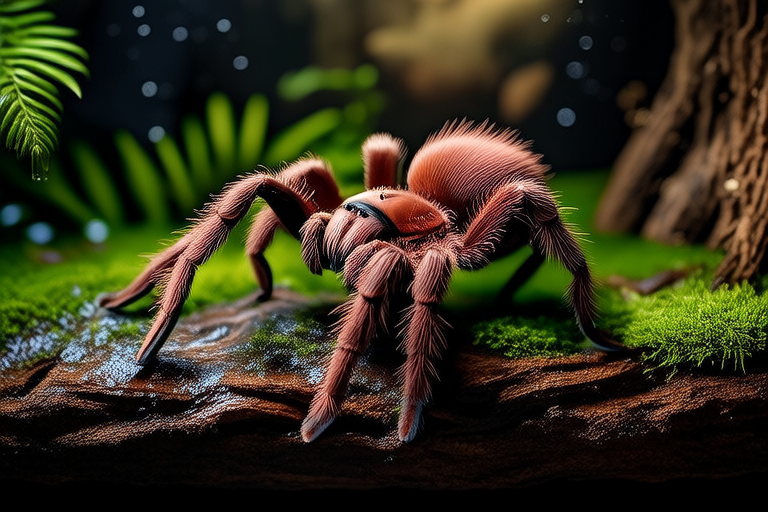The Ultimate Chilean Rose Tarantula Habitat Setup for Happy Arachnids
Welcome to the world of Chilean rose tarantulas! These captivating arachnids are a favorite among both beginners and experienced keepers due to their manageable size, docile nature, and striking appearance. To ensure your pet tarantula thrives, it’s crucial to provide a habitat that closely mimics its natural environment. This comprehensive guide will walk you through every aspect of setting up the perfect Chilean rose tarantula habitat, from choosing the right enclosure to maintaining optimal conditions.
Selecting the Appropriate Enclosure Size
When it comes to housing your Chilean rose tarantula, size matters. A general rule of thumb is to provide at least five gallons of space per inch of tarantula. For most adults, a 10-gallon tank or equivalent enclosure is sufficient. However, larger enclosures offer more room for exploration and exercise, which can contribute positively to your tarantula’s overall well-being. Avoid overcrowding by ensuring there’s ample space for your tarantula to move around comfortably.
Substrate Types
The choice of substrate plays a significant role in creating a comfortable and healthy environment for your Chilean rose tarantula. Opt for substrates that retain moisture without becoming soggy. Popular choices include coconut fiber, cypress mulch, and eco-earth. These materials not only help maintain the desired humidity levels but also provide a naturalistic aesthetic that mimics the tarantula’s native habitat. Ensure the substrate is deep enough (at least three inches) to allow burrowing, a behavior essential for the tarantula’s comfort and stress reduction.
Temperature and Humidity Requirements
Maintaining the correct temperature and humidity is vital for the health of your Chilean rose tarantula. The ideal temperature range for these arachnids is between 78°F and 85°F (25°C to 29°C). Use a reliable thermometer to monitor the temperature within the enclosure. Additionally, aim for humidity levels between 60% and 80%. Achieve this by misting the enclosure daily and ensuring proper drainage to prevent water accumulation. Consistent monitoring of these parameters helps prevent respiratory issues and other health problems associated with improper environmental conditions.
Ventilation Needs
Proper ventilation ensures fresh air circulation within the enclosure, preventing the buildup of harmful gases and maintaining optimal oxygen levels. While it’s important to avoid drafts, which can cause temperature fluctuations, some airflow is necessary. Consider adding mesh lids or vents to the enclosure to facilitate air exchange while keeping predators out. Positioning the enclosure away from direct sunlight and heat sources further aids in maintaining stable temperatures.
Hiding Spots
Chilean rose tarantulas are naturally reclusive creatures that seek out hiding spots to feel secure. Incorporating various hiding options such as cork bark tubes, half logs, or ceramic caves provides them with multiple choices for resting and molting. These structures should be placed strategically around the enclosure to encourage exploration and reduce stress. Offering a variety of hideouts allows your tarantula to choose its preferred spot based on its mood or activity level.
Decor Elements
Enhancing the enclosure with decor elements not only adds visual appeal but also enriches the living space for your tarantula. Incorporate branches, vines, and artificial plants to create a more naturalistic setting. These additions serve dual purposes: they provide additional climbing opportunities and add layers to the enclosure, making it more interesting for your pet. Choose items that are safe, non-toxic, and easy to clean. Regularly inspect and replace any decaying or damaged decor to maintain a hygienic environment.
Lighting Considerations
While Chilean rose tarantulas don’t require UVB lighting, providing a consistent day-night cycle helps regulate their circadian rhythms. Position a low-wattage incandescent bulb or a specialized reptile heat lamp outside the enclosure to create a basking spot. Ensure the light source doesn’t directly expose the tarantula to intense heat, as excessive warmth can be detrimental. Alternatively, consider using a red LED bulb for nighttime observations without disturbing your tarantula’s sleep patterns. Always monitor the temperature near the heat source to prevent overheating.
Feeding Arrangements
Proper nutrition is key to maintaining your Chilean rose tarantula’s health. Feed appropriately sized prey items such as crickets, dubia roaches, or mealworms once or twice a week. Offer food items no larger than one-third the width of the tarantula’s abdomen to prevent choking hazards. Place feeder insects in a shallow dish or release them into the enclosure under supervision. Remove uneaten prey after 24 hours to avoid potential harm to your tarantula. Maintaining a balanced diet supports growth, molting processes, and overall vitality.
Maintenance Tips
To keep your Chilean rose tarantula’s habitat clean and inviting, establish a regular maintenance routine. Clean the enclosure weekly by removing waste and replacing soiled substrate. Perform deeper cleans every few months, thoroughly disinfecting all surfaces and decorations. Use mild, pet-safe cleaning solutions to avoid introducing harmful chemicals. Regular maintenance prevents the accumulation of bacteria, fungi, and parasites that could jeopardize your tarantula’s health.
Monitor your tarantula closely for signs of illness or distress, such as lethargy, loss of appetite, or unusual behavior. Early detection allows for prompt intervention, potentially saving your pet’s life. Consult a veterinarian specializing in exotic animals if you notice concerning symptoms. Regular check-ups can also help identify underlying health issues before they become severe.
Conclusion
Creating a thriving habitat for your Chilean rose tarantula requires attention to detail and commitment to replicating its natural environment. By carefully selecting the appropriate enclosure size, substrate, temperature, humidity, ventilation, hiding spots, decor elements, lighting, and feeding arrangements, you’ll provide your pet with an enriched and stimulating living space. Whether you’re a novice keeper or an experienced enthusiast, following these guidelines ensures the happiness and longevity of your beloved Chilean rose tarantula. With dedication and care, your arachnid companion will thrive in its new home.
